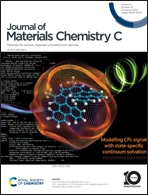A stable trigon-based 3D carbon allotrope with ultralow lattice thermal conductivity†
Abstract
Hexagon, pentagon, and four-membered ring-based carbon allotropes have been extensively studied in recent years due to their novel properties and vast applications. As the ring size reduces, the internal stress increases significantly, making the design of trigon-ring-based carbon allotropes challenging. In this work, we propose a novel trigonal ring-based three-dimensional (3D) carbon structure, Tri-C20, composed of double-fused trigons connected to hexagons. State-of-the-art first-principles calculations reveal that Tri-C20 is not only dynamically and mechanically stable but can also maintain its structural integrity at high temperatures of up to 2000 K. Tri-C20 is semiconducting with a quasi-direct bandgap of 4.65 eV and a high Vicker's hardness of 35.59 GPa. More interestingly, different from the most reported trigon-based 3D carbon allotropes that are metallic with high thermal conductivity contributed by electrons, Tri-C20 possesses an ultralow lattice thermal conductivity of 1.5 W m−1 K−1 at 300 K, which can be further reduced to 0.8 W m−1 K−1 at 600 K, showing its potential towards thermal management applications.



 Please wait while we load your content...
Please wait while we load your content...